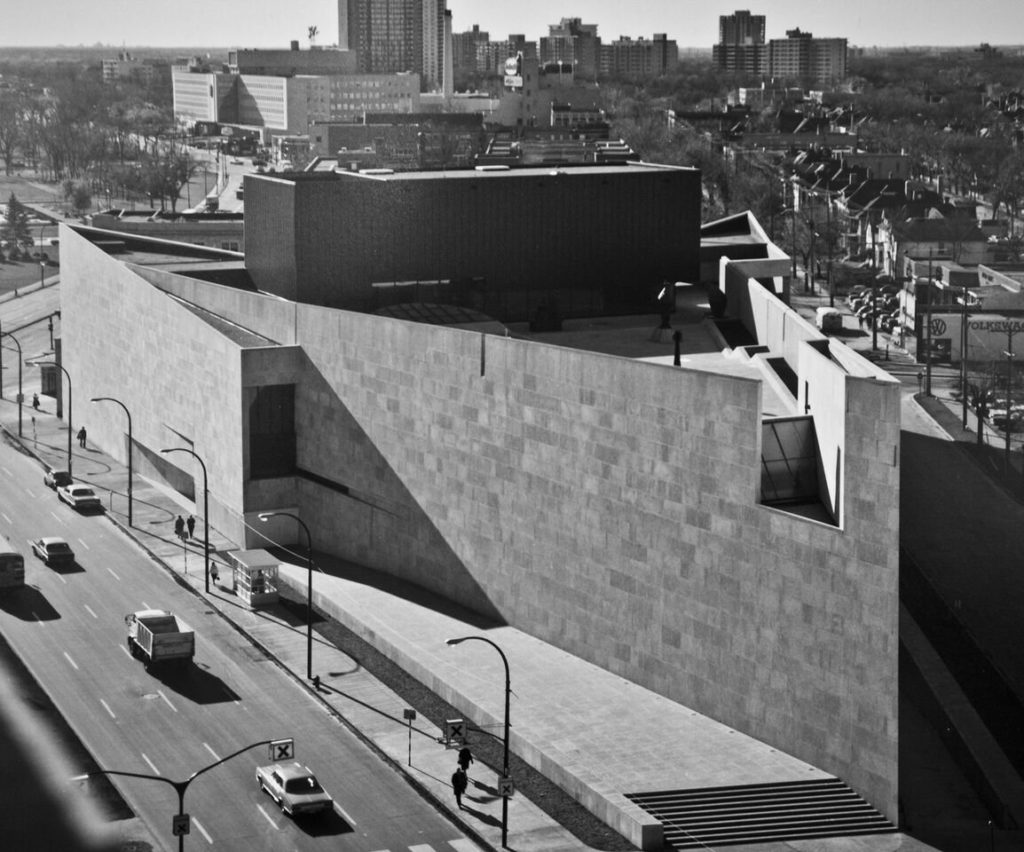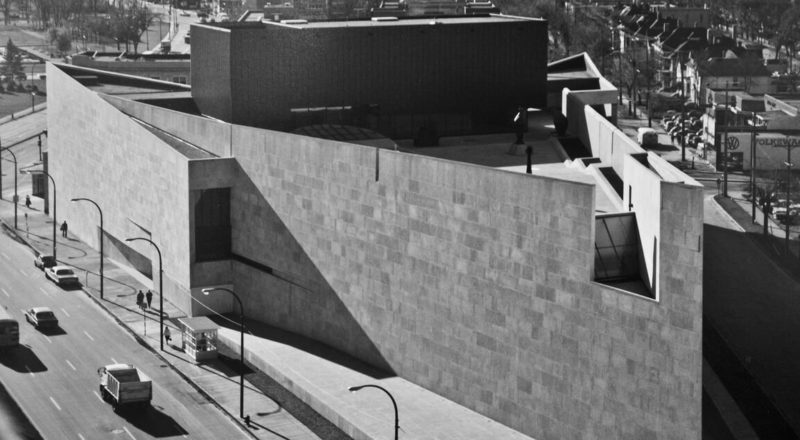
/ Blog
May 7, 2020
The Winnipeg Art Gallery: Modernist ARTchitecture
A stunning expression of modernist architecture, the Winnipeg Art Gallery is home to celebrated works by some of the greatest artists from our past and present. Inside its sheer limestone walls you can find exhibits that range from rare to avant-garde, from exotic to local, including “the world’s largest public collection of modern and contemporary Inuit art” (WAG). It is a place for our community to enjoy art in all its forms, offering art classes, lectures, films, resources and more. The Winnipeg Art Gallery (WAG) gives us the opportunity to see a wide variety of art from all over the world, while local exhibitions also document of our history in the form of historic landscapes and characters captured in paintings, drawings, and sculptures. It has featured beautiful Greco-Roman statues in the Olympus exhibit and renowned works by Van Gogh, Picasso, and Warhol. Local artists exhibited include the Group of Seven’s Lionel LeMoine FitzGerald, one of Winnipeg’s best known early modernist painters, and Anishinaabe artist Norval Morrisseau, who’s mural, Androgyny, speaks to the decolonizing gesture of reconciliation. Through this art we can connect to the past and learn about our heritage — it is truly the beating heart of the outstanding Winnipeg Art Gallery.
In Manitoba’s early 1900s, it would appear that art was not as big a commodity as it is now. Artists like FitzGerald and W.J. Phillips (who spent several decades working in Winnipeg) were not as recognized then. Landscape work by artists Paul Cézanne (a Post-Impressionist painter) and Georges Seurat (a Post-Impressionist and Neo-Impressionist painter) greatly influenced FitzGerald. Eventually, Phillips became known as the nation’s finest woodcut artist in England from 1924-1925.
After a slow start, the interest in arts was gradually growing. From 1890 to 1913, the artistic movement began to emerge in Winnipeg. Lack of documentation of the development of art in Manitoba keeps us from knowing exact details of the western arts (the art of western Europe where artists took inspiration from European paintings and applied the same styles to paintings in Canada) but we do know of some important moments in art history in Canada.
In 1887, a group of women organized an art club in London, Ontario, inspired by the Art Student’s League of New York. This art club worked together with different forms of art including painting, modelling, drawing, and sketching from still lifes and models. Mary Ella Dignam, founder and first president of the club, wanted to encourage women’s interest in the arts. At a time where women were expected to devote their time to their husbands and children, Dignam managed to balance her family and art life. She studied the arts in Europe and in the late 1800s trained at the Art Student’s League of New York. Her quest for knowledge also led her to travel to Italy and Holland to learn more about painting and to view art. When she came back to Ontario she began to teach other women about different styles of art. Her promotion of women artists encouraged them to create beautiful works and gave them the opportunity to work alongside men. The group exchanged ideas about art by hosting art exhibitions and holding lectures. By 1907, the association officially became the Women’s Art Association after the House of Commons in Ottawa passed a bill incorporating the group.
The bill, called Bill No. 30 An Act To Incorporate The Women’s Art Association of Canada reads:
The objects of the Association shall be the creating of a general interest in art and the encouragement of women’s work for the purpose of mutual help and co-operation of its members, the establishment of art lectures and reading clubs, the holding of exhibitions of painting, designs, sculpture, engraving and the industrial arts, and the encouragement and development of the art handicrafts and home industries of Canada.

An undated image of the Winnipeg Art Gallery at 300 Memorial Boulevard.
Source: Number Ten Architectural Group (CC BY-SA 4.0, via Wikimedia Commons)
In 1903, the Manitoba Society of Artists was established followed by the Western Art Association and the Searchlight Art Club in 1910. With these new societies, Winnipeg began to place a greater emphasis on the importance of art in the community.
According to the Manitoba Historical Society, the first publication of the Manitoba Society of Artists explained the increasing appreciation for art in Canada:
Manitoba has outgrown the pioneer stage and there is much encouragement in the fact that in its sudden rise in well-being the feeling has not been lost that something more is needed than material comfort.
In 1920, a school of landscape painters founded the Group of Seven. The school presented works of the northern boreal forest in the Canadian Shield as a spiritual force. The Group of Seven was known for their brightly coloured paintings of the Canadian Prairies and other landscapes. People recognized these paintings as romanticized versions of Canadian confidence and independence.
The original Group of Seven consisted of Franklin Carmichael, Lawren Harris, A. Y. Jackson, Frank Johnston, Arthur Lismer, J. E. H. MacDonald, and F.H. Varley. Today, the Group of Seven is known to have included of some of the most important Canadian artists of the 20th century alongside Tom Thomson, David Milne, and Emily Carr. The Group temporarily disbanded due to the First World War, when Jackson and Varley became war artists. After the war, the group rejoined and would travel throughout Ontario while sketching landscapes and developing their art. FitzGerald eventually join the group in 1932 — a year before the Group of Seven disbanded. Despite the Group’s separation, FitzGerald would go on to be one of the founding members of the Canadian Group of Painters, a successor to the Group of Seven. Some work by the Group of Seven is still at the Winnipeg Art Gallery today including a series of beautiful oil paintings by FitzGerald.
In 1912, the WAG was established after a group of Winnipeg businessmen each contributed $200 to open a gallery. These businessmen were members of the Industrial Bureau and because of their interest in helping Winnipeg’s art scene, they formed themselves into an art committee. They appointed Scottish artist Donald Macquarrie as the first curator because of his previous experience opening a studio in Winnipeg in 1910. The civic gallery would take place in two rented rooms in Winnipeg’s Federal Building in the downtown area at the corner of Main and Water Streets. The WAG would relocated multiple time, moving throughout the city to better accommodate its growing collection, including spending time at what is now the Manitoba Archives Building.
While at the Manitoba Archives Building location at 200 Vaughan Street, a Dr. Ferdinand Eckhardt began to help with the gallery’s transformation. Eckhardt had immigrated to Canada in 1953 after developing a division of art education for the Australian government. In Canada, he worked as director of the WAG. Eckhardt’s guidance over the gallery allowed it to start an ambitious exhibition program leading the acquisition of Canadian and international works such as the Gort Collection of late Gothic and early Renaissance art. In 1960, the Winnipeg Art Gallery acquired George Swinton’s Inuit style sculptures. These 130 sculptures plus the addition of artist Jerry Twomey‘s collection of approximately 4000 works of Inuit art in 1971 led the way to the gallery showcasing the largest collection of contemporary Inuit art in the world today. Eckhardt would held the position as director until he retired in 1974.
When Eckhardt arrived in Winnipeg, the WAG’s home was also used to host concerts, festivals, dances, roller skating, boxing, and wrestling. Eckhardt deemed the space insufficient for an art gallery and together with the Women’s Committee, Eckhardt urged the city for better facilities. In 1971, Eckhardt’s dreams finally became a reality with the opening of a new WAG building. Winnipeg architect, Gustavo da Roza had designed the new structure at 300 Memorial Boulevard. Made with a smooth, pale Tyndall stone facade, the four-storey building cost approximately $4.5 million when the Bird Construction Company to erected it between 1969-1971. The gallery was partly funded by contributions from the federal ($500,000) and provincial ($1.25 million) governments and included a citizens’ campaign that raised $1,076,000 and $854,000 in private donations.
The construction of the WAG on Memorial Boulevard was specific— it had to be well-built while also encompassing functionality, aesthetic, and incredible architecture. The modernist building’s triangular-like shape is supposed to be reminiscent of a ship rising on its own ocean. According to Roza, the limestone walls of the gallery that crystallize are said to represent the character of the northern prairie environment. The sharp shapes of the exterior are clean-cut, reflecting the contemporary aesthetic of a world class art gallery. The mechanics in the inside of the building were also strategically designed to allow the spaces to remain at a controlled temperature and humidity to best preserve the art.
The WAG was officially opened by Her Royal Highness The Princess Margaret, Countess of Snowdon, on September 25, 1971. The building included eight galleries, a 320-seat auditorium, sculpture garden and restaurant on the roof, gift shop, research library, and a large space for meetings and lectures. In 1995, the WAG expanded its size by building a new WAG Studio Building north of the main building. Professional artists would teach art classes to adults and children alike, becoming the largest program of its kind in Canada!

Princess Margaret unveiling the Winnipeg Art Gallery commemorative plaque (May 1974).
Source: Archives of Manitoba.
Over the years, the WAG has gone through a few renovations. From 2003 to 2005, the gallery’s vault storage was expanded to make space for managing and transporting collections. From 2008-09, the WAG replaced its roof. These renovations helped keep the museum in top condition, ready to host a variety of programs, tours, and exhibitions. Over the years, the WAG has established itself as one of the leading art museums in Canada through hosting work by local, national, and international artists alike. Exhibitions that are at the Winnipeg Art Gallery now have toured around the globe from places like Spain, Mexico, Taiwan, Norway, Italy, China, and the United States. As Winnipeggers we should be very proud to have a world-class facility!
Today, the Winnipeg Art Gallery is the oldest and 6th largest civic gallery in Canada and continues to grow. In 2018, the gallery started the construction of a new WAG Inuit Art Centre to create a sense of the North. The $65-million centre will house the largest collection of Inuit art in the world. The centre is expected to be completed in fall 2020.
Our heritage is full of art, with the WAG helping share and preserve that history. The gallery is home to nearly 24,000 works of art from the 15th to 21st century, from artists around the world. Through collecting work by and supporting Canadian artists, the gallery will continued to preserve the country’s visual arts heritage for years to come!
THANK YOU TO THE SPONSOR OF THIS BLOG POST:

Written by Georgia Wiebe on behalf of Heritage Winnipeg.
Edited by staff.
SOURCES:
Christopher Varley and Russell Bingham, The Canadian Encyclopedia, Group of Seven
Find a Grave, Mary Ella Williams Dignam
Manitoba Historical Society, Memorable Manitobans: Lionel LeMoine Fitzgerald
Manitoba Historical Society, Memorable Manitobans: Walter Joseph Phillips
McMichael Canadian Art Collection, Group of Seven
Russel Bingham, The Canadian Encyclopedia, The Winnipeg Art Gallery
The Robert McLaughlin Gallery, A Vital Force: The Canadian Group of Painters
Winnipeg Architecture Foundation, Architects Gustavo Uriel DA ROZA,
Winnipeg Art Gallery, Olympus Exhibit
Winnipeg Art Gallery, Tom Thomson and the Group of Seven
Women’s Art Association of Canada, History since 1887











